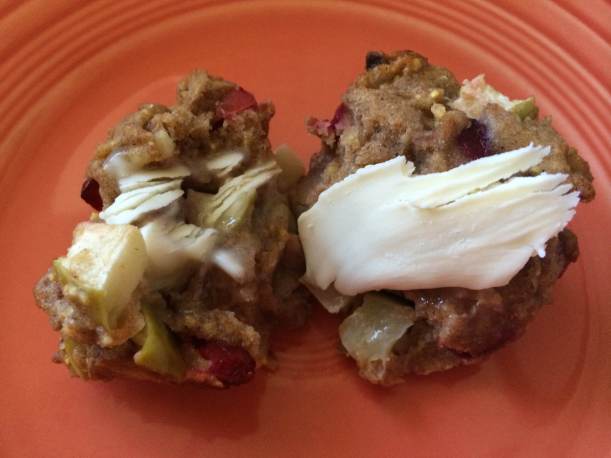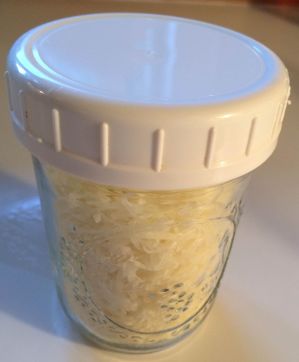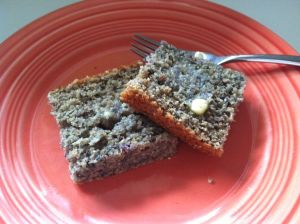Before we get down to these scrumptious muffins with the craggy tops, filled with whole grains, fruits and nuts, I have a few flower pictures from around our neighborhood.
We love muffins at our house, and these are one of our favorites {we have too many favorites to choose just one!}. My recipe is adapted from the Apple-Cranberry Muffins recipe found in Once Upon a Tart {Mentesana and Audureau}, which is one of my favorite cookbooks. Once Upon a Tart is “New York City’s favorite bakeshop and cafe.” I have never been there, but if I ever make it back to New York City, I will be sure to drop in for lunch and dessert. Karen Dennis posted the original muffin recipe on her blog, and you can find it here. I haven’t met many recipes I didn’t want to play around with in some way, so today I will share my spin on this tasty muffin. It is a delicious muffin, particularly when you top it with a smear of good butter. Speaking for myself, it is important to remember the butter, salted or unsalted, when you enjoy a muffin or slice of quick bread {or any bread for that matter}. Butter offers up a delicious creamy contrast to the fruit and nut goodness that are these muffins, making them even more delicious than when au natural. So, without further adieu. . .
I love muffins with eggs {fried eggs in particular} and a fresh spring vegetable. This was a tasty and healthy breakfast, I might add!
Look how craggy the tops are, with tender morsels of Granny Smith apples, tart-sweet cranberries, chewy apricots & crunchy walnuts. There is no shortage of nooks and crannies for butter to hide. Delicious!
It just looks like a lot of butter, but isn’t really!
Apple, Cranberry & Apricot Muffins
adapted from Once Upon a Tart’s Apple-Cranberry Muffins
We still have a bag of cranberries in the freezer, which are totally fine, but I’m sure blueberries would also be awesome in these muffins, if you don’t have cranberries.
1 1/2 cups whole wheat flour
1/4 cup medium grind cornmeal
1/4 cup dark rye {light rye would be fine}
1 tbsp flax seed meal
3/4 tsp baking powder
3/4 tsp cinnamon
1/2 tsp salt
2 large eggs
1/2 cup sugar
3/4 cup neutral flavor oil {I used organic canola oil}
1 tsp vanilla
1 cup broken walnuts
1 medium size tart apple, such as Granny Smith, cored but not peeled, and cut into 1/2 inch dice
1 cup whole frozen {or fresh} cranberries
3/4 cup chopped dried apricots {preferably California apricots, as they are tastier and less sweet than Turkish apricots}
Grease 12 muffin cups with butter or pan spray. Preheat the oven to 400 degrees Fahrenheit.
Whisk the dry ingredients together in a medium size bowl until well mixed.
In a large bowl, whisk the eggs to break up the yolks. Add sugar and continue to whisk for a few minutes, until the mixture begins to pale in color. Whisk in the oil and vanilla.
Gradually add the dry ingredients to the wet, stirring with a wooden spoon until just a little flour is visible. Add the walnuts, apples, cranberries and apricots. Stir gently until there is no trace of flour visible.
Divide the batter evenly into your muffin cups, filling them almost to the top.
Place the muffin tin onto the center rack of the oven, and bake for 20 minutes, until a toothpick comes out clean or with just a few moist crumbs. Do not over-bake. Remove the muffins to a cooling rack and cool completely, except those that you will enjoy warm {with a swipe of good butter!}.
Notes:
- I leave the apple unpeeled; we like the chewiness that the peel adds {and fiber too!}.
- We get our dried apricots from Trader Joe’s. This is one of the items we ask people to bring to Maui when they ask, “Do you want anything from Trader Joe’s?” The answer, of course, is a resounding “YES!” We like the California Slab Apricots Blenheim Variety.
- I think I have established elsewhere on this blog that I prefer large pieces of nuts in baked goods, so the walnuts are broken. There are a few exceptions to this rule, but not many.
- Muffins freeze well, wrapped in a zipper lock bag {squeeze out as much air as you can}.
Bon appétit!






































